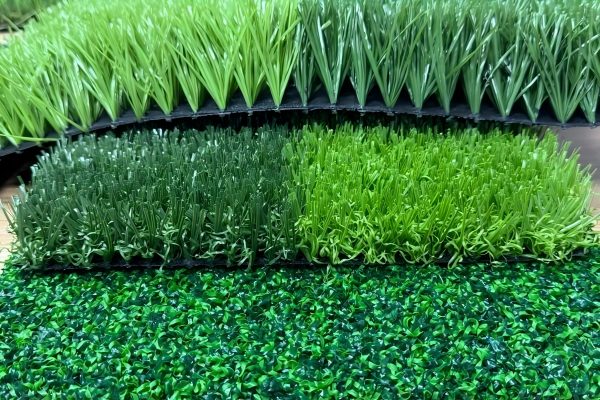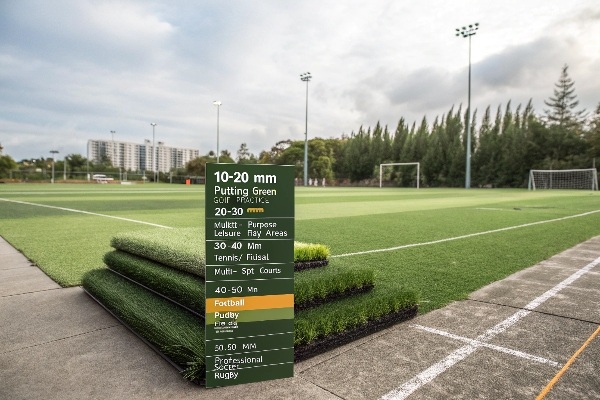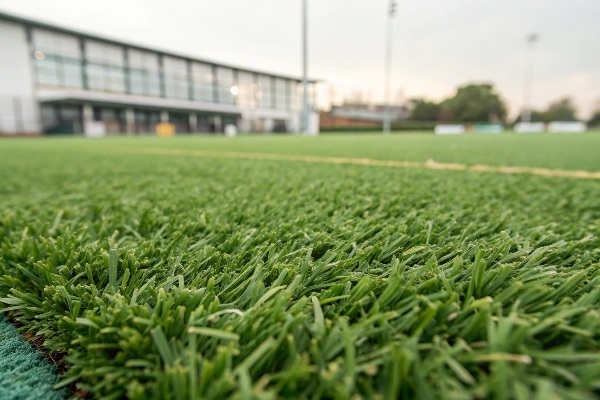Confused about turf thickness for your sports field? A wrong choice wastes money and impacts game play. Let’s find the perfect thickness for your cricket or football project.
The best thickness, or pile height, depends entirely on the sport. Football turf is typically 40-60mm high to provide cushioning and good ball behavior. Cricket turf is much shorter, around 10-15mm, to ensure a consistent and fast ball bounce for the wicket area.

I’ve seen many clients struggle with this question. They often think that a thicker, longer pile height automatically means better quality, but that’s a common and costly misunderstanding. The real secret is matching the turf’s specifications to the function of the field. It’s not just about how it looks or feels underfoot; it’s about performance, player safety, and the longevity of your investment. Let’s break this down further so you can confidently choose the right product for your project.
What is the best thickness for artificial turf?
Choosing the "best" turf thickness feels like a puzzle. One wrong move and your field’s performance1 suffers. The best thickness is simply the one perfectly suited for its intended use.
There is no single "best" thickness. For high-impact sports like football or rugby, 40-60mm is standard. For sports requiring a true, fast bounce like tennis or cricket, a shorter pile of 10-20mm is better. The application determines the optimal thickness.

When we talk about thickness, we’re really talking about "pile height2," which is the length of the grass blades from the backing to the tip. This is probably the most important specification to get right for a sports field. The ideal pile height is all about how the ball and the players will interact with the surface. I remember working on a multi-sport facility where the client initially wanted to use the same thick, 50mm turf across the entire area, including a cricket pitch. I had to explain that while that turf was perfect for the football section, a cricket ball would just die on that surface. It wouldn’t bounce correctly. We ended up specifying two different products. This experience taught me to always start with the question: "What game will be played here?"
Matching Pile Height to Sport
The needs of a football player are completely different from those of a cricket player. A football field needs to cushion falls, allow for slide tackles, and provide a predictable ball roll. The longer fibers (40-60mm) combined with infill give it the right properties. A cricket pitch, however, needs to be hard and fast to replicate a rolled natural wicket.
The Role of Infill
Pile height doesn’t work alone. A 50mm football turf is designed to hold a significant amount of infill, usually a mix of sand and rubber granules. This infill is what provides the shock absorption and stability. The grass fibers hold the infill in place. A shorter turf simply cannot hold enough infill to be safe for a high-impact sport like football.
| Sport/Application | Typical Pile Height | Key Consideration |
|---|---|---|
| Football/Rugby | 40mm – 60mm | Player safety, shock absorption |
| Cricket (Wicket) | 10mm – 15mm | Fast, consistent ball bounce |
| Tennis/Hockey | 15mm – 25mm | True ball roll and speed |
| Landscaping | 25mm – 45mm | Aesthetic look and soft feel |
What thickness is cricket3 turf?
Planning a cricket pitch? An incorrect surface can create an unpredictable and unsafe game. The key is a very short, dense turf for a consistent, professional-level ball bounce.
Artificial cricket turf for the wicket (the pitch) is typically between 10mm and 15mm thick. This short, dense pile provides the hard, fast, and consistent surface needed for a proper ball bounce. The surrounding outfield can be thicker, around 25-35mm.

The main purpose of an artificial cricket wicket is to create a surface that plays like a well-prepared, hard-rolled natural pitch. This means the bounce must be predictable and fast. A long, soft turf would be a disaster. The ball would sink into the fibers and bounce slowly and at an odd height, which is dangerous for the batsman. That is why we use a very specific type of turf for the wicket area. The fibers are short, but they are also incredibly dense. This high density is what gives the surface its hardness. I once helped a sports club that tried to save money by using a standard 25mm turf for their new wicket. The players complained immediately. The ball’s bounce was too slow and unpredictable. We had to replace it with a proper 12mm high-density cricket turf. The difference was immediate. The game became faster, safer, and much more enjoyable for the players.
Wicket vs. Outfield
It’s important to understand that a cricket ground has two different turf areas with different needs.
- The Wicket: This is the central strip where the main action happens. It requires the specialized short, dense turf (10-15mm) for performance.
- The Outfield: This is the large surrounding area. Its primary job is to allow for smooth ball roll and be safe for fielders who are running and diving. A pile height of 25-35mm is often suitable here, providing a bit more cushion than the wicket.
Comparing Cricket Surfaces
| Surface Area | Recommended Pile Height | Primary Function |
|---|---|---|
| Wicket | 10mm – 15mm | Provide a fast, true, and predictable bounce |
| Outfield | 25mm – 35mm | Ensure smooth ball roll and fielder safety |
This two-turf approach ensures professional-level play on the wicket while keeping the overall project more cost-effective.
Is thicker turf better?
Does a thicker turf automatically mean it’s better quality? This common assumption can lead to costly purchasing mistakes. Let’s explore why "better" is about function, not just fiber length.
No, thicker turf is not always better. While thicker turf (e.g., 40-50mm) can feel more lush and is great for landscaping or some sports, it can be unsuitable for others like cricket or tennis. The best turf has the right thickness, density, and yarn quality.

As an engineer in this industry, this is the myth I have to correct most often. Clients see a long, plush pile height and think it must be the most durable, premium option. But pile height is only one part of the story. A cheap, 50mm turf with a low stitch density and thin fibers (low Dtex) will flatten very quickly under foot traffic. It might look good on day one, but it won’t perform well or last long. In contrast, a well-made 40mm turf with high density and a strong yarn will outperform and outlast it significantly. I always tell my clients to think of it like buying a winter coat. A very puffy coat filled with low-quality material won’t keep you as warm as a thinner coat made with premium, dense insulation. Quality is about the materials and construction, not just the thickness.
Thickness vs. Density
These two factors work together. A long pile height needs a high stitch density to help the fibers stand upright. If the density is too low for the height, the blades will have no support and will lie flat. A shorter turf can sometimes be far more durable because its dense construction provides excellent resilience.
Other Factors Define "Better"
When judging quality, you must look beyond pile height.
- Dtex: This is the weight of the yarn per 10,000 meters. A higher Dtex means a thicker, more resilient fiber.
- Stitch Rate: This is how many stitches are in a given area. Higher density means more fibers, better coverage, and more durability.
- Backing Quality: The backing holds everything together. A strong, well-coated backing is crucial for the turf’s lifespan.
| Consideration | When Thicker is Better | When Shorter is Better |
|---|---|---|
| Application | Landscaping for a lush look, football fields | Sports requiring fast ball-surface interaction (cricket, tennis) |
| Durability | Not necessarily; depends on density and Dtex | Often more resilient in high-traffic areas if density is high |
| Maintenance | Requires more infill and regular brushing | Can be easier to clean and maintain |
| Cost | Often higher due to more material used | Can be more cost-effective |
Conclusion
Choosing the right turf thickness is about matching the product to the sport. Focus on performance needs for football or cricket, not just pile height, to ensure a successful project.
-
Understand the connection between turf thickness and overall sports performance for various games. ↩
-
Explore how pile height influences the interaction between players and the ball, impacting game quality. ↩
-
Find out why specific turf thickness is essential for cricket to ensure a consistent and safe playing surface.
| ↩
_画板-1.png)
_画板-1.png)